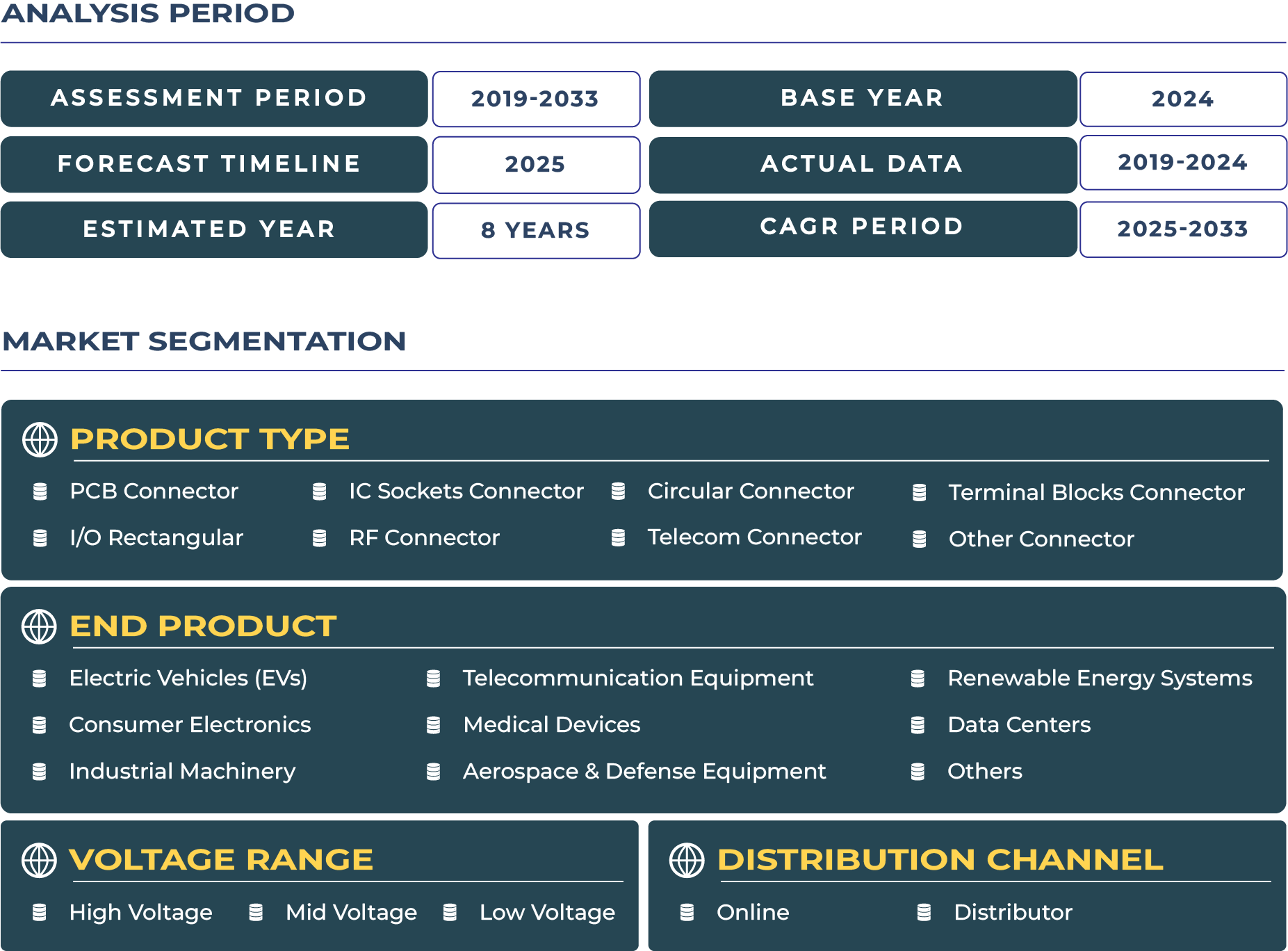Australia Connector Market Outlook
Hybrid Signal-Wireless Connectivity: Powering Australia’s Infrastructure Modernization
Australia’s vast distances and critical infrastructure needs are forging a new paradigm in connector design. As the nation advances its railway networks, defense systems, and remote regional electrification, the connector ecosystem is shifting toward compact hybrid solutions that blend wired reliability with wireless flexibility. Australia connector market is projected to reach USD405 million by 2033, at a CAGR of 6.4%. This growth is driven by ongoing infrastructure modernization and the increasing integration of advanced connectivity solutions in critical sectors such as transportation and defense.
Compact Hybrid Connectors: The Backbone of Australia’s Remote Railway and Defense Networks
Australia’s expansive rail projects, including the Inland Rail upgrade, demand durable connectors capable of handling power, data, and wireless communication in a single compact footprint. Hybrid connectors—combining power lanes with Wi‑Fi or cellular modules—enable real-time condition monitoring without compromising reliability in dusty, temperature-extreme environments. In mid‑2024, ARTC specification updates included circular hybrid connectors for on‑train telemetry systems, ensuring robust RF performance consistent with rugged circular design standards. These hybrid solutions reduce cable bulk, simplify installation, and optimize rail readiness across remote routes.
Driving Forces and Constraints in Australia’s Connector Sector
Infrastructure renewal and energy efficiency imperatives are fueling demand for hybrid connector solutions. The migration to LED street lighting across cities like Brisbane has involved replacing older telecom connectors with compact I/O rectangular hybrids featuring sensor interfaces and IoT-ready wireless integration. Meanwhile, rail system electrification and upgrades call for modular circular connectors that interconnect power, control, and wireless subsystems within constrained coach panels. These developments underscore clear market momentum.
Yet the connector sector confronts notable obstacles. High-speed connector testing—especially for telecom-grade hybrid units—requires specialized labs capable of RF and EMC certification. Australia’s limited domestic capacity in this domain extends validation cycles by 20–30%, affecting supplier access timing. Additionally, maintaining signal integrity across NASA-grade connective paths in aggressive coastal environments introduces reliability concerns. Without thorough prequalifications, performance risk remains high, adding cost and elongating procurement lead times.
Emerging Trends and Strategic Opportunities in Hybrid Connectivity
Two key trends are shaping Australia’s connector landscape:
- Wireless + Wired Hybrid Modules: Australian OEMs deploying IoT hubs in remote agricultural and environmental monitoring contexts now favor hybrid connectors that consolidate connectivity functions.
- Low-Profile Assemblies: Urban defense technology and compact rail monitoring platforms increasingly utilize low-profile board-to-board connectors for sensor arrays and control panels. Defence prime IMPECPT deployed sub-6 mm pitch PCB connectors within electric UAV ground-control stations, showcasing compact integration.
These trends reveal two distinct market opportunities:
- Bridge Interfaces for Remote IoT Hubs
Vendors that engineer connectors with built-in wireless bridges and ruggedized housings stand to capture emerging demand from Australia’s remote infrastructure projects. - Ultra-Thin Connector Solutions for Compact Systems
Suppliers offering minimal board-to-board assemblies with high mating cycle performance can serve sectors prioritizing compactness—like UAV control, portable defense electronics, and compact transport modules.
Regulatory Framework Advancing Connector Standards
Australia’s communications authority has mandated new connector specifications since late 2023, requiring all railway and defense-connected panels to meet EMC and RoHS standards and include serial-number traceability. These requirements align with national rail and defense infrastructure policies, reinforcing the adoption of connectors with certified hybrid and environmental protection attributes. Compliance ensures market access to major government contracts and establishes quality benchmarks across the connector ecosystem.
Economic and Compliance Drivers Shaping the Market
Economic indicators are critical in understanding connector market dynamics. Australia’s urbanization rate now stands at 86%, fueling demand for smarter, compact electronics and rail systems—aligning with the connector sector’s expansion. Compliance standards also drive performance: RoHS compliance now exceeds 95% among electronics integrators, influencing terminal block and I/O connector design frameworks. While logistics costs remain about 12% above the OECD average—particularly in remote areas—the value derived from hybrid, multi-functional connectors mitigates total installed cost, enabling Australia to optimize its connectivity infrastructure despite distribution challenges.







